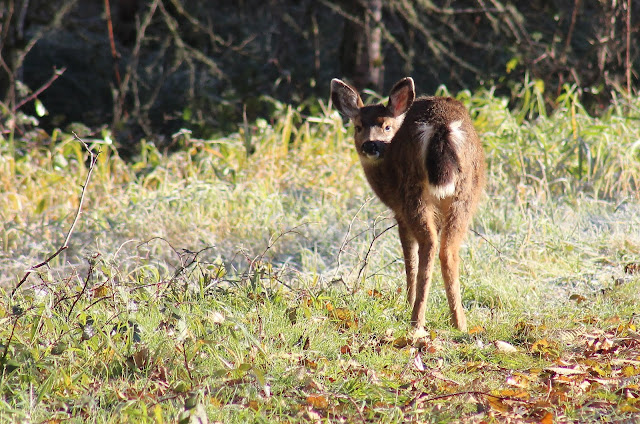I drove out to
Nisqually National Wildlife Refuge for the weekly Bird Walk. There were about 20 participants, mostly
‘regulars’, but a few new folks assembled with us at 8 a.m.
 |
| Nisqually Birders |
The birds were pretty active in the Orchard
this morning, as soon as the sun came up.
We found a very busy mixed-species feeding flock of chickadees and
kinglets, and found a Hutton’s Vireo in the group. There was a lot of ice on the Visitors’
Center pond, but a few dozen ducks were active and keeping patches of open
water.
 |
| Female Shoveler in front, Mallard hen in back. Keeping the ice open |
We were thrilled to see a
Trumpeter Swan do a fly-by, and three Snow Geese came in to land south of the
north dike.
 |
| Adult (left) and two immature Snow Geese |
A couple black-tailed deer
were grazing along the way.
 |
| Columbian Black-tailed Deer fawn |
We had our usual
‘brunch break’ at the Twin Barns overlook, then continued out to the dike and
the estuary boardwalk.
 |
| Birding the North Dike at Nisqually |
The mid-low tide
was +6.2 feet at 10:11 a.m.,
 |
| Nisqually surge plain at low tide |
flooding toward a 14.0-foot high water at 3:27
p.m., so we started out on the boardwalk with a lot of mud showing, and the
tidal push brought the ducks and peeps in for closer looks by the time we returned.
 |
| Nisqually surge plain at high tide |
A couple of
drake Eurasian Wigeon showed-off their red heads and gray flank plumage
 |
| Drake Eurasian Wigeon - Mareca penelope |
Compared to the
American Wigeon with their gray heads and rufous flank feathering
 |
| American Wigeon drake - Mareca americana |
Many of the wigeon were feasting on sea lettuce. From the holes in the leaf, I would guess that this is Ulva fenestrata
 |
| Salad for lunch |
Other water bird
species included, among others, Green-winged Teal, Pintails, and shorebirds
 |
| Greater Yellowlegs |
 |
| Least Sandpiper showing its yellow legs. Our other common sandpipers have dark legs |
 |
| Green-winged Teal hen |
Unfortunately,
the north wind blew in some plastic trash – including this Mylar Murrelet. Plastic balloons cause thousands of wildlife
mortalities each year – especially in marine waters where albatrosses and sea turtles
mistake them for their usual prey:
Jellyfish
 |
| There's no escaping the trash . . . |
At the Nisqually
River overlook, several California Sea Lions were hunting chum salmon on the
flood tide
 |
| California Sea Lions Zalophus californianus, one of the 'eared' seals |
This muskrat was
so intent on feeding on aquatic forbs that it paid no attention to the many
birders 10 meters away!
 |
| Muskrat Ondatra zibethicus focused on its lunch |
There is no
sign-up requirement to attend a Wednesday bird walk at Nisqually. An entrance fee of $3 per car is required,
unless you have one of the many Federal Lands Passes (Interagency Annual Pass, Senior
Pass, Access Passport, Federal Duck Stamp, or an
Annual Refuge Pass) which entitle you to
‘free’ admission. Hope to see you there
one of these times.
 |
| Winter Hornets' Nest |
Nisqually NWR eBird Checklist Here
















No comments:
Post a Comment